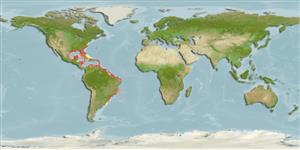Common names from other countries
Classification / Names / Names
Namen | Synonyme | Catalog of Fishes (gen., sp.) | ITIS | CoL | WoRMS
Environment: milieu / climate zone / depth range / distribution range
Ökologie
; tiefenbereich 1 - 130 m (Ref. 96392). Tropical
Western Atlantic: Caribbean Sea to southern Brazil. Tropical to subtropical.
Length at first maturity / Size / Gewicht / Alter
Maturity: Lm ? range ? - ? cm
Feeds primarily on gastropods, bivalves and small crustaceans, and sometimes on amphipods, isopods, crabs, smaller echinoderms and fish larvae (Ref. 96392).
Life cycle and mating behavior
Geschlechtsreife | Fortpflanzung | Ablaichen | Eier | Fecundity | Larven
Members of the class Asteroidea exhibit both asexual (regeneration and clonal) and sexual (gonochoric) means of reproduction. Life cycle: Embryos hatch into planktonic larvae and later metamorphose into pentamorous juveniles which develop into young sea stars with stubby arms.
Alvarado, J.J. and J. Cortés. 2009. (Ref. 83942)
IUCN Rote Liste Status (Ref. 130435)
CITES Status (Ref. 108899)
Not Evaluated
Not Evaluated
Bedrohung für Menschen
Harmless
Nutzung durch Menschen
| FishSource |
Tools
Mehr Information
Alter/GrößeWachstumLänge-GewichtLänge-LängeMorphologieLarvenDichte
Internet Quellen
Estimates based on models
Preferred temperature
(Ref.
115969): 21.4 - 27.7, mean 24.7 (based on 498 cells).
